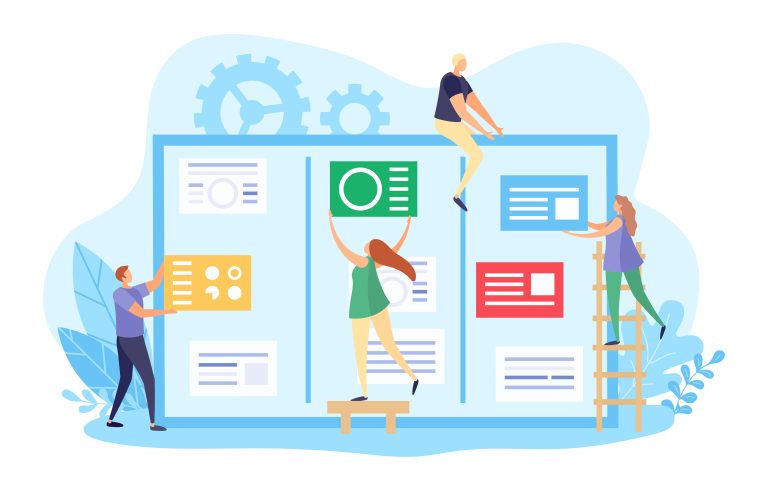Kanban is a Japanese term that means card or sign board and is known for being a visual management methodology, with information cards that record industry actions.
Kanban is an essential part of good project management, with a simple, efficient and straightforward approach to demand management.
When looking for agile methods, one of the first ones you will usually come across is Kanban.
Its popularity is for a reason: it is a simple method to apply and that provides quick results.
In this article you will understand what the Kanban method is, how it works and how you can implement it in your industry.
What is Kanban?
Kanban is a visual work management system that seeks to guide each task through a predefined workflow.
The concept of Kanban is characterized by its visual system, which consists of a method established in a table containing delimiting columns. This system makes it possible to subdivide work into segments or states, through the arrangement of cards organized in columns, which indicate the position of each task in the workflow. The cards describe the actual work that goes through the process.
This concept is also based on establishing a work-in-progress limit, which allows you to assign limits on how many items can be in-progress in each segment or state of the workflow.
The Kanban method can be implemented using cardboard cards or through visual signals in stocks. The essential thing is that these elements contain crucial information such as codes, part names, suppliers, storage locations, consumption, among others.
The purpose of this methodology is to avoid procrastination and increase productivity in everyday life. The entire system is guided in an organized way to make the workflow more productive.

Emergence of the Kanban method
Created by Taiichi Ohno, Kanban emerged within the Toyota production system. It plays an important role in production system pulled and in the concept just in time.
The idea arose after the Japanese went to the United States to visit American factories.
At the time, supermarkets worked as follows: the customer delivered the list of desired items and the employee went to the stock to remove them.
However, when they arrived in the US, they were inspired by supermarkets as we know them today, in which consumers circulated with a cart and had free access to product stocks.
Taiichi Ohno was impressed with how supermarkets kept shelves stocked with just the right amount of each product. So, upon returning to Japan, he switched to paper cards to sign and track demand in his factory, naming the new system “Kanban”.
What is the purpose of the Kanban methodology?
The focus of Kanban is to prioritize productivity and the organization of deliveries. The objective is to provide a more transparent and targeted work.
It serves to install continuous and gradual improvements.
By following its principles, you can improve your workflow, increasing customer value.
The objectives of Kanban can be made clearer by talking about the types of Kanban that exist.

What are the types of Kanban?
Just like the concept lean manufacturing, Kanban is not limited to just one way of implementing or acting, it adapts to what your company needs.
production kanban
Production kanban is usually divided into three columns: doing, doing, done.
As the activity progresses, the team will “pull” the tasks. Thus, the cards are moved from step to step until the task is completed.
Each card contains data about the activity to be performed. Colors can indicate the progress of the activity or its segment.
movement kanban
In this model, the pace of production becomes proportional to the pattern of consumption and the turnover of items.
The objective is to control incoming and outgoing stock, balancing production with the volume of products available on the market.
In this type, the idea of the cards follows the same as that of production, however, they determine the need for production of the product, being moved as the volume of stock changes.
It is common to find two variations: an internal Kanban, to control the company's own production; and an external Kanban, to control suppliers and third parties.
E-Kanban
E-Kanban is an adaptation of the method for the digital environment, but the strategy remains the same.
However, being digital it offers some unique benefits, such as:
Make communication easier: as it is digital, it can be used as an environment for discussion, as it allows adding comments and mentioning members who are involved in the activity.
Allows the attribution of responsible: on each card can be added responsible for carrying out the task.
Assign delivery dates: makes it possible to define dates for the delivery of activities, and as the deadline ends, those involved are notified of the remaining time limit.
Timestamp: in digital format it is possible to calculate how many hours are being spent on each activity.
Prevents loss of information: all Kanban data is saved in the cloud, which prevents progress from being lost. This advantage is only possible in the digital format, as in the physical format post-its may fall and information is lost.
Benefits and advantages of Kanban
It is already more than true that this method is efficient and innovative, but more than that, it adds several benefits. These are some of them:
Productivity
As Kanban provides data and activity status, classifies by priority and is easy to understand, it causes a great impact on productivity, as it shortens paths and directs the worker to the goal.
cost reduction
With the Kanban board, managing the time spent on each activity becomes easier. This way you can understand where there is a greater investment of time and money, and can even identify where the production bottlenecks, and by identifying them, your company also reduces waste.
team unification
Kanban values collaboration.
With the jobs centralized on the same board, the team is able to move in the same direction, identifying where and when they should go.
That way, if an employee has any difficulty, you can see exactly where the problem is and a colleague can help you.

How to implement Kanban
With so many benefits and plausible results, implementing Kanban becomes more and more attractive.
If you want to adopt the method, but don't know where to start, the following steps will help you.
First step: map the processes
Mapping the processes is the first step towards the implementation of Kanban, whatever type you are going to implement in your company.
That's because, to implement it, you need to know your company's production process to identify which stages of the process have priority and who is responsible for them, and what is the best way to organize the columns.
Depending on the type of Kanban you are going to apply, the steps may vary.
Second step: prioritize and standardize steps
After mapping the processes, the next step consists of defining the standardization of colors, names and priorities. In addition to defining which color will represent certain information.
Third step: train the team
There are those who consider this the first step, as it is also essential for the method to give results.
However, by mapping the processes, prioritizing and standardizing the steps, you can train your team by teaching the concept, why to implement it and what the benefits are, focusing on the type of Kanban that will be most emphatic in your company and the data you managed to analyze in the previous steps.
So, if doubts arise about the method, application or what influence it will have on the day-to-day production process, you will already have the answers.
Fourth step: continuous improvement
Kanban aims and makes it possible to improve processes, increase productivity and optimize the production line.
Apply continuous improvement to achieve the objectives and acquire the benefits proposed by this methodology.

Why not apply Kanban?
In this article you found all the information about one of the most applied methodologies today, you understood the concept, the origin, its objectives, benefits and how to apply it.
If after all this you are still wondering: “why not implement the Kanban method in my company?” and you still haven't reached the answer, it's simple: there's no reason not to adopt this method!
Follow the first two steps on how to apply and assess which areas of your company can benefit from this application.
Take a test and measure the results brought by the application of the new methodology. You will see how much difference it can make to your business.
An example of its efficiency is the very cradle of its birth: the automotive manufacturer Toyota, which in February 2016 was the 13th largest company in the world by revenue, and today occupies the eighth place in that ranking.
Did you like this content? If so, the articles just in time It is lean manufacturing may be interesting topics for you!
And if you are looking to improve the management of your industry, management software is also a great tool for you. meet the BMS Manufacturing 360, the system made to make the industry more efficient!

















